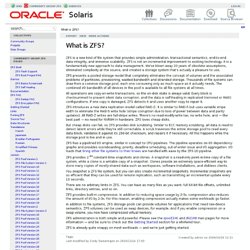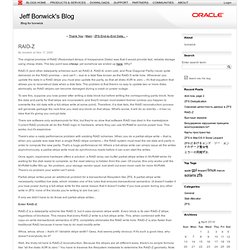

ZFS Self Healing (Community Group zfs.selfheal. ZFS Basics Screencast (Community Group zfs.basics. What is ZFS? (Community Group zfs.whatis. ZFS is a new kind of file system that provides simple administration, transactional semantics, end-to-end data integrity, and immense scalability.

ZFS is not an incremental improvement to existing technology; it is a fundamentally new approach to data management. We've blown away 20 years of obsolete assumptions, eliminated complexity at the source, and created a storage system that's actually a pleasure to use. ZFS presents a pooled storage model that completely eliminates the concept of volumes and the associated problems of partitions, provisioning, wasted bandwidth and stranded storage. Thousands of file systems can draw from a common storage pool, each one consuming only as much space as it actually needs. The combined I/O bandwidth of all devices in the pool is available to all file systems at all times. All operations are copy-on-write transactions, so the on-disk state is always valid.
ZFS introduces a new data replication model called RAID-Z. ZFS provides built-in compression. ZFS (Community Group zfs.WebHome. Oracle Solaris 11 ZFS Administration Guide Oracle Solaris 11 ZFS Resources Oracle Solaris 11 Downloads What is ZFS? A brief overview of ZFS features Documentation Man Pages, Admin Guide, Slides Discuss ZFS community discussion Code Source Code Tour Demos Screencasts and other demos EnglishEspañolFrançais日本語PortuguesePусский简体中文 ZFS is a new kind of file system that provides simple administration, transactional semantics, end-to-end data integrity, and immense scalability.
ZFS Features Pooled Storage Model Always consistent on disk Protection from data corruption Live data scrubbing Instantaneous snapshots and clones Portable snapshot streams Highly scalable Built in compression Simplified administration model For a more detailed look at these features, and more, check out What is ZFS? RAID-Z (Jeff Bonwick's Blog) The original promise of RAID (Redundant Arrays of Inexpensive Disks) was that it would provide fast, reliable storage using cheap disks.

The key point was cheap; yet somehow we ended up here. Why? RAID-5 (and other data/parity schemes such as RAID-4, RAID-6, even-odd, and Row Diagonal Parity) never quite delivered on the RAID promise -- and can't -- due to a fatal flaw known as the RAID-5 write hole. Whenever you update the data in a RAID stripe you must also update the parity, so that all disks XOR to zero -- it's that equation that allows you to reconstruct data when a disk fails. The problem is that there's no way to update two or more disks atomically, so RAID stripes can become damaged during a crash or power outage. To see this, suppose you lose power after writing a data block but before writing the corresponding parity block. There are software-only workarounds for this, but they're so slow that software RAID has died in the marketplace.
Enter RAID-Z. ZFS RAID levels » ZFS Build. ZFS RAID levels ZFS RAID levels When we evaluated ZFS for our storage needs, the immediate question became – what are these storage levels, and what do they do for us?

ZFS uses odd (to someone familiar with hardware RAID) terminology like Vdevs, Zpools, RAIDZ, and so forth. These are simply Sun’s words for a form of RAID that is pretty familiar to most people that have used hardware RAID systems. Striped Vdev’s (RAID0) Striped Vdev’s is equivilent to RAID0. Mirrored Vdev’s (RAID1) This is akin to RAID1. Striped Mirrored Vdev’s (RAID10) This is very similar to RAID10. RAIDZ (RAID5) RAIDZ is very popular among many users because it gives you the best tradeoff of hardware failure protection vs useable storage. RAIDZ2 (RAID6) RAIDZ2 is like RAID6. RAIDZ3 This is like RAIDZ and RAIDZ2, but with a third parity point.
Nested RAID levels – You can also add striped RAIDZ volumes to a storage pool. We have decided to go with Mirrored Striped Vdev’s (RAID10).